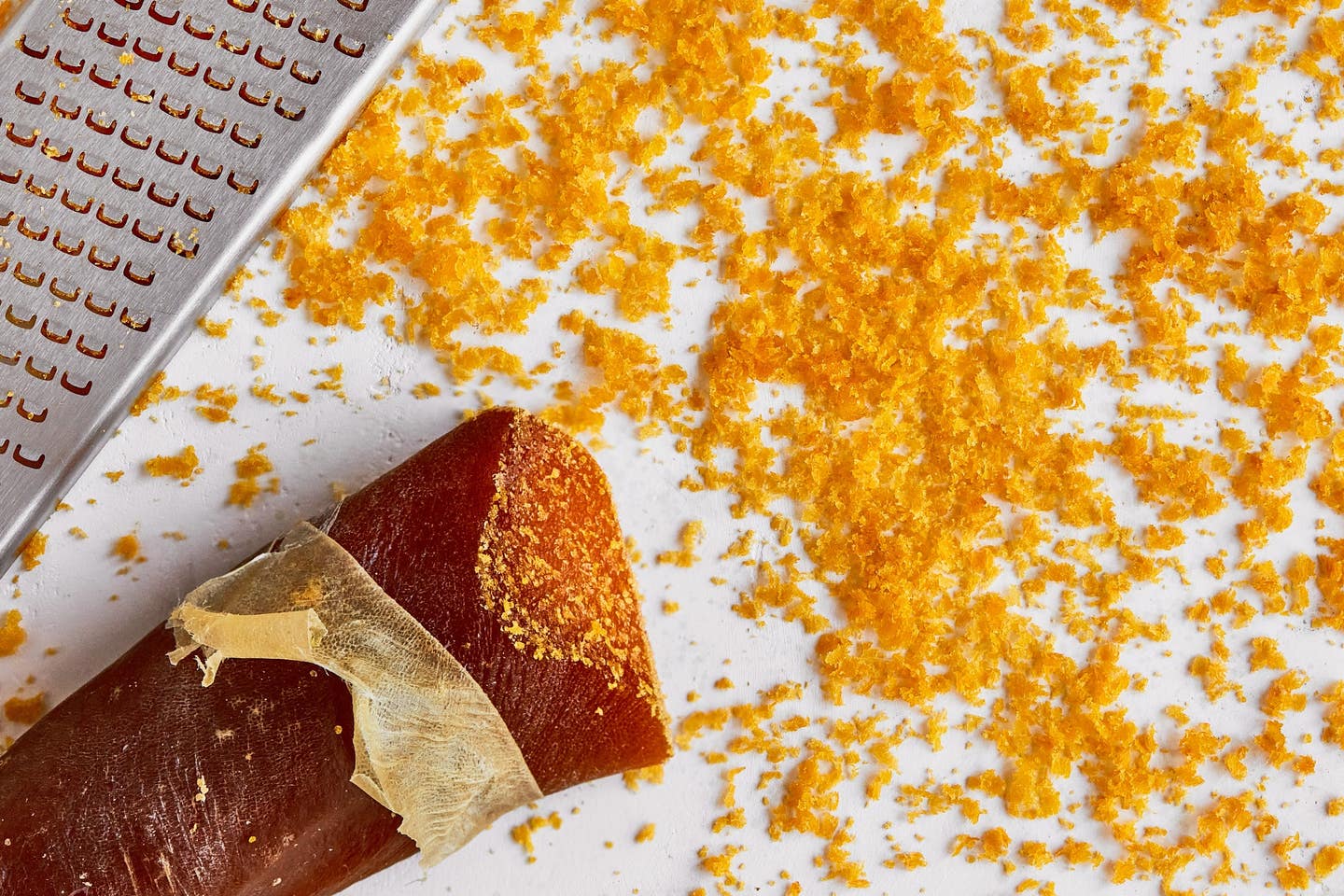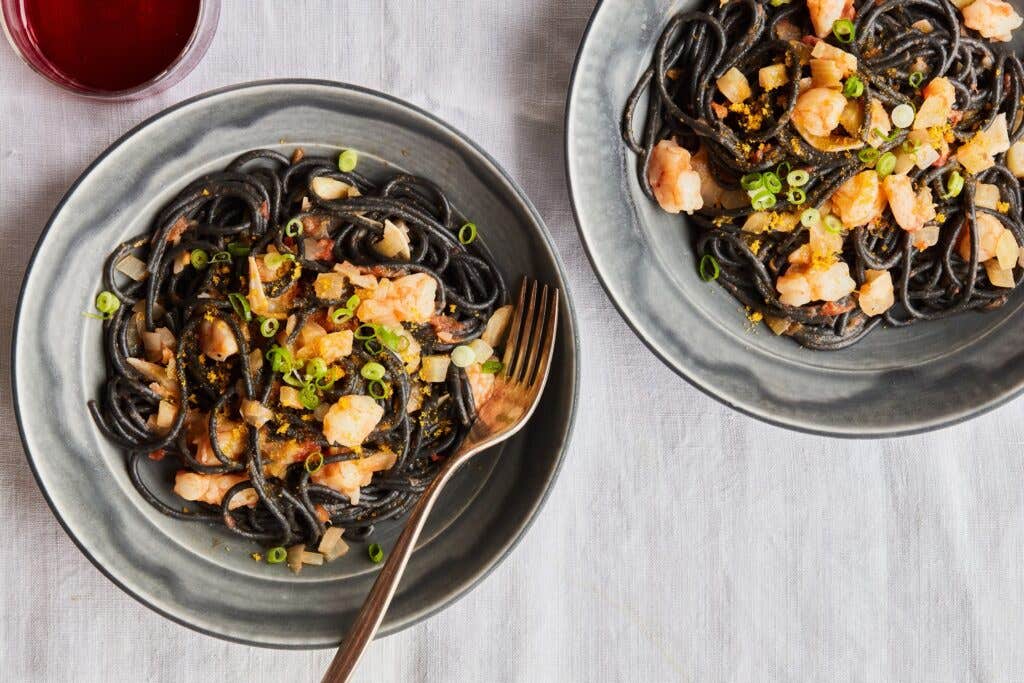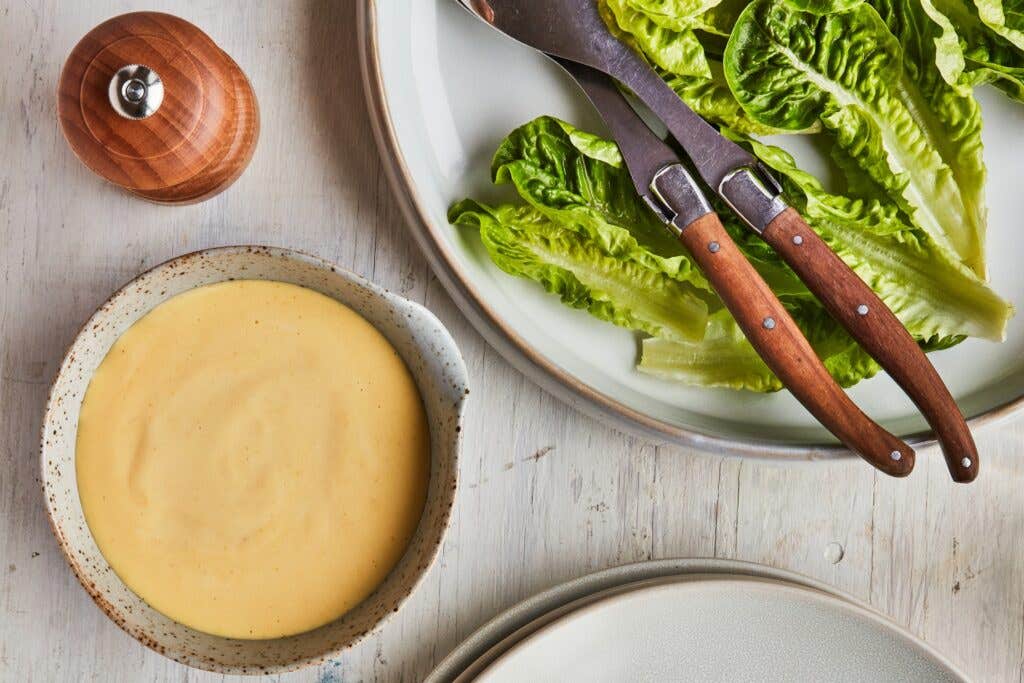
Once a Coastal Carolina Staple, Mullet Roe Is Making Waves Again with Local Chefs
Bottarga is back, baby!
The first fish roe I ever encountered was on my grandad’s breakfast plate, one sunny North Carolina morning, mixed up with scrambled eggs, alongside a mug of black coffee. I’d most likely spent the night at my grandparents’ house, so all was exotic anyway, but my grandmother gently brushed my curiosity aside. “You know, Pa-paw fishes,” she explained, steering me calmly to my cinnamon toast. Over time, this memory faded—that is, until my work covering the foodways of the American South brought me back to my own Carolinian roots.
Mullet has been a North Carolina delicacy for generations. Historically, local fishermen and their families enjoyed the fish’s roe after a lucky morning catch, just as Pa-paw did: fried up fresh with eggs and grits as part of a late breakfast. However, in some area fishing communities, the large lobes were preserved, as pictured in a photo from the State Archives of North Carolina. Taken in Onslow County sometime in the 1930s, the image clearly shows several sacs of salted roe, laid out to dry in the sun on wooden slats.
Variations on this technique exist all over the world today. In fact, from Egypt to Korea, many coastal cultures have a tradition of cured mullet roe—a prized delicacy made only during the spawning season, when fish which normally live in temperate and tropical saltwater lagoons, creeks, and estuaries, head for the open ocean in large schools to mate. Although regional differences abound, Italian bottarga is most often made from the prized flathead grey mullet (Mugil cephalus) which live in Sardinia’s salt lakes and in the harbor lagoons off the Tuscan coast. But the species thrives in temperate and tropical regions worldwide, so it makes sense that a similar product could be easily made elsewhere. Once the mullet are caught, their delicate egg sacs are carefully removed, then salted and left to slowly dry until most of their water has evaporated and the soft lobes have concentrated to a firm and gratable pantry staple.
In the United States, the niche ingredient had all but faded away until fairly recently, when Mediterranean bottarga began popping up shaved over pasta dishes at seafood-forward Italian restaurants. In the meantime, a widespread taste for umami-rich foods, from Parmesan to fish sauce to fermented black beans, has contributed to a renewed interest in salted roe, with its distinctive taste of the sea.
According to the Monterey Bay Aquarium Seafood Watch, the striped grey mullet is “highly fecund, relatively short-lived, with a low age at maturity,” making it overall relatively resilient to heavy fishing, and thus earning the organization’s “Best Choice” designation—effectively the top recommendation for sustainable seafood. The fish are an important food source for a lot of other ocean creatures within their ecosystem, so some limits are in place; however, the mullet typically run in massive schools of more than 10,000 pounds of fish—far more than even the largest commercial boats can pull in.
One of the United States’ top mullet producers is the State of Florida, and in fact, Seth Cripe of Cortez (home of the “Cortez hot dog”—a smoked mullet in a bun) was the first to market a domestically produced bottarga nationally. Others followed, and until recently, North America’s limited bottarga production seemed to be centralized in the Sunshine State. That is, until North Carolina’s Locals Seafood, a hybrid wholesale and retail fishmonger and restaurant with locations in Raleigh and Durham, began producing it in 2018.
“I love mullet,” says Locals’ chef Eric Montagne, who is spearheading the operation. The Florida transplant, who grew up in the Keys, didn’t always feel that way. As the son of a commercial fisherman, when he started working in kitchens, he instead looked inland, studying whole animal butchery to get away from the water. But when he moved further north to work for Vivian Howard at eastern North Carolina’s now-shuttered Boiler Room, the local mullet on the menu brought him right back to his roots. As he began to delve into the state’s local foodstuffs, seafood, including mullet—usually fried or grilled—became more and more a part of his cooking. He began to apply his knowledge of whole-animal butchery and sustainable protein preservation, but with an emphasis on seafood.
“When you’re using fish filets, that’s only like 55 percent of the animal.” he tells me. “I started to ask, ‘What could we do with that other 45 percent?’” He began using the roe to make his own bottarga, but in restaurant kitchens, he often struggled with sourcing a steady supply. That is, until he started leading the kitchen at Locals Seafood and suddenly had access to the distributor’s expanded buying power. “Finding the roe was always a scavenger hunt,” he recalls. “I could only ever make a small batch.”
Historically, North Carolina has been one of the largest producers of mullet, at one time fueling Westward expansion through a robust dried fish export business to workers building American railroads. These days, the state’s catch is mainly auctioned off to Japanese and Italian brokers or sold domestically to the booming recreational angler market for use as bait. Coastal residents still enjoy old local traditions like grilled mullet, or fried roe and eggs—just like Pa-paw liked it—but those old-school practices aren’t enough to sustain an industry. Offshore fish like snapper, jack, tuna, grouper, and wahoo continue to crowd the market as marketing efforts, consumer tastes, and the “premium” appeal of larger and harder-to-harvest fish overshadow the humble mullet.
“But people still fish for mullet,” says Glenn Skinner, Executive Director of the North Carolina Fisheries Association, himself a commercial fisherman. And “roe-grade” mullet is by far the most prized, despite the fact that a 1,000-pound catch typically only yields about 150 pounds of roe. In 2019, North Carolina fishermen sold just over 550,000 pounds of exclusively roe-grade mullet, most of which was exported to other continents.
But the industry is still struggling. Mullet catches were slowly declining over the past decade (both changes in the ecosystem as well as industry response to lagging demand) and they took a sharp downturn in 2020 when borders closed due to the COVID-19 pandemic, halting the supply chain for much of the overseas seafood market. “A domestic culinary consumer mullet market would help sustain us,” Skinner says.
And it's at just that inflection point that Montagne and his team look to effect change—while also minimizing kitchen waste and creating a profitable specialty product. Because of the wholesale company’s 12 years of building relationships with fishermen, they can buy more fish than the average restaurant, thus helping Montagne boost production of his North Carolina bottarga.
Nowadays, the Locals team cures an average of 300 pounds of bottarga a year. Most of it is used in-house, though Montagne parcels out a percentage of the production to select area chefs, and a sample from each batch is sent to the UDSA for shelf-stable approval. Later this year, Locals will expand into a larger facility which will allow the chef to increase bottarga production and continue developing other cured seafood products—from fish sausage to crunchy fish organ dog treats.
Although by commercial standards Montagne’s production is low, he and other chefs are helping realize the much greater potential for restoring North Carolina mullet and its roe to to its former glory—and its rightful place in the American palate, whether through a microplane of salty, sea-scented crumbles atop a bowl of pasta, or a plate of fresh roe, eggs, and grits (a fisherman’s treat I now order every time I spy it on a diner menu). Pa-paw would be proud.
Where To Buy Bottarga
Although Locals Seafood does not currently ship its house-cured bottarga, that is set to change soon: Montagne and his team plan to move into their new production space in time for the 2022 autumn mullet run. In the meantime, domestic versions may be ordered online from both Clearwater and Cortez, Florida; imported Sardinian bottarga is available on Amazon.
How To Use Bottarga
In Durham, some 30 miles or so northwest of Raleigh, chef Josh DeCarolis at Mothers & Sons Trattoria uses Locals bottarga in riffs on traditional Italian cuisine. One of his most popular menu items is squid ink tonnarelli, tossed with local shrimp, fennel, scallions, and bottarga butter. The dish is finished with a flourish of grated bottarga. “I’ve never been a fan of eggs and roe, so seeing someone here use [the ingredient] for a different purpose is exciting,” he says. Bottarga speaks to tradition, and I like to rely on it to add another layer of depth.”
As for the taste, DeCarolis thinks Locals’ version stands up to the Italian stuff. “I’ve used bottarga for years, and this one is very special…It’s a little more concentrated and drier, like the taste of ocean water.”
Montagne, on the other hand, loves to promote the ingredient’s potential for mass appeal, stressing that one lobe can last the average home cook close to a year. “It’s shelf stable, so just store it in a jar or a bag in the pantry and grate it fresh. The more you use it, the more ways you’ll find to use it.” And at Locals’ restaurant, he introduces uninitiated diners to the house bottarga in approachable ways, either incorporated into a Caesar dressing or shaved atop hot french fries. The cured roe’s nuanced flavors and aromas bloom when warmed, and as the marigold-colored shavings cling to the chef’s crispy potatoes, the heat of the fryer releases an unmistakably oceanic fragrance.
Recipes


Keep Reading
Continue to Next Story










